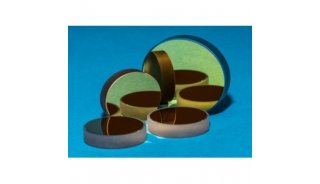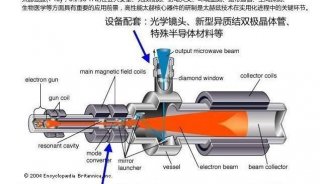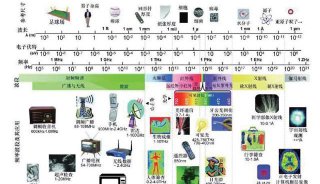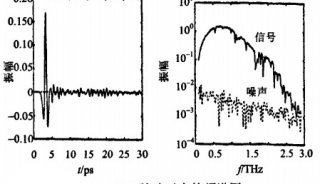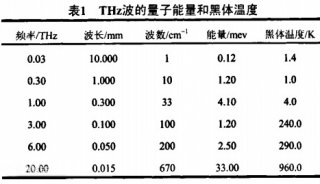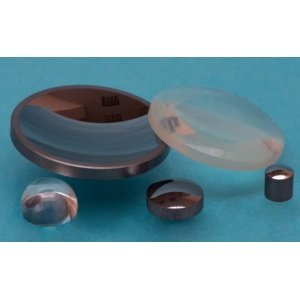太赫兹信号源Terahertz sources(三)
4. Terahertz surface emission—transient currents
Terahertz emission can result from a changing dipole. The terms current surge, surge current or transient current are alternative ways of describing this. The transient current itself may arise because of carrier drift, due to the surface electric field, or due to diffusion; these currents are respectively referred to as drift currents (section 4.2) and diffusion currents (section 4.1).
Experimentally, there are several signatures of a transient-current emitter [136]. Rotating a magnetic field in the plane of the sample surface will change the direction of the Lorenz force on the charge carriers. This will either add to or subtract from the motion leading to terahertz emission and consequently an increase and decrease in the terahertz emission is observed. So, for example, bulk InP (1 1 1) crystals exhibit a transient current effect, whereas nanoporous InP (1 1 1) crystals do not [127]. Likewise, the dependence of the terahertz generated on the excitation fluence can give insight into the emission mechanism. Transient current emitters tend to saturate, as a result of charge screening, as the optical fluence increases. Charge-carrier screening, as well as terahertz absorption in the material, imply heavily doped semiconductors in general are not good emitters. For example, in measurements of InP doped in the range n-type 7 × 1018 cm−3 to p-type (8–10) × 1018 cm−3, the highest signal was from nominally undoped (<1 × 1016 cm−3) InP [136].
4.1. Diffusion currents
Diffusion currents arise when charge carriers of opposite sign diffuse at different rates. Typically, diffusion currents dominate for high carrier energies [137]. A dipole is formed if the positive and negative charge carriers diffuse at different rates. This is known as the Dember effect (or the photo-Dember effect) [138–140]. It is usual that electrons are more mobile than holes. It is often a good approximation to think of the holes as stationary. Usually, diffusion is away from (perpendicular to) the surface. The case of diffusion along (parallel to) the surface is termed the lateral effect. This direction of the current is optimal for coupling out of the surface. The lateral photo-Dember effect was first reported by pumping (1 0 0) GaAs and In0.53Ga0.47 on InP at 825 nm [141]. Subsequently the effect was observed under pumping with an Er : fibre (1.55 µm) laser [142]. The effect has also been observed in semi-insulating and low-temperature grown GaAs [143]. A cylindrical micro-lens array was found to increase the output power five-fold [144]. The effect of the spot position and size and an external bias have been investigated [145], as have the dependence on fluence and polarization [143].
4.2. Drift currents
Typically, drift currents dominate for high electric fields [137]. Drift currents are influenced strongly by the local surface field, as illustrated by experiments involving passivated surfaces [146]. For this reason, emission due to drift currents is sometimes termed surface-field emission.
4.3. Modelling
Monte Carlo modelling has been used to simulate the motion of photoexcited charge carriers and so clarify the mechanisms of terahertz emission. The landmark work is that of Johnston et al [147]. This demonstrated that InAs is predominantly a photo-Dember, or diffusion, emitter and GaAs is predominantly a surface-field, or drift, emitter. Moreover, the improvement of emission with a magnetic field is largely due to geometric reorientation of the radiating dipole (rather than a change in the dipole strength). Magnetic-field enhancement of terahertz emission had been reported for InSb, InAs, InP, GaSb and GaAs in modest magnetic fields (up to 1.2 T) [148] and attributed to increased radiation from transient currents in the surface plane [149]. Other Monte Carlo modelling work has identified the roles of hot and cold charge carriers [150] and explored the roles of the photon energy of the pump beam [151, 152], large electric fields [153], and the cross-over from drift to diffusion emission [154]. InSb [155] and InAs [155, 156], GaAs p–i–n structures [157], and δ-doped and other heterostructures [158–162] have been investigated. Similar modelling has also been carried out on terahertz photoconductive emitters [163] and detectors [164].
Modelling allows parameters that are difficult or perhaps impossible to vary in practice to be varied in the simulation, with a view to understanding how terahertz emission might be improved. Consider the case of InAs [165]. Scattering is seen to play a minor role. The terahertz emission with all scattering mechanisms included in the simulation (polar optical phonon, carrier–carrier, intervalley, and ionized impurity) differs little from the emission with no scattering at all. The transport, on the sub-picosecond timescale, is almost collisionless. Likewise, varying the dielectric constant or the surface field has little effect. Varying the band gap or the effective mass have a noticeable effect, which can be understood in mechanical terms—if the electrons or holes are given greater kinetic energy, the dipole resulting from the motion of the charge they carrier will change more rapidly. It is also clear from the simulation that, during typical pump pulses of 100 fs, there is sufficient time for the initially-created electrons to move away from the surface and so create an opposing potential even before the peak of the pump pulse arrives. The existence of such a vanguard counter-potential implies that shorter (<100 fs) excitation pulses not only improve the bandwidth but also improve the strength of the terahertz emission [156, 165].
The case of InAs may be contrasted with that of GaAs [166]. There are significant differences. Polar optical phonon scattering plays a large role in reducing the output of terahertz radiation from GaAs surfaces. The effect of the surface potential is great; the terahertz field not only reduces as the surface potential does, but reverses in direction as the sign of the surface potential changes. There is a vanguard counter-potential in GaAs, but it is weaker than in InAs. Overall, InAs is the stronger emitter [166].
Finally, by way of synthesis, it might be remarked that both optical rectification (section ) and transient currents (section 4) may simultaneously produce terahertz emission. For example, in both InSb and InAs it is observed that the azimuthal-angle varying difference frequency mixing is superimposed on a considerable surge current; moreover, as the temperature is varied, so is the terahertz emission, very markedly for InSb, indicating the presence of the photo-Dember effect [167]. On the other hand, in InP bulk difference frequency mixing is observed to be comparable to the effects of transient currents [168].
5. Terahertz emission from mechanical excitation
Is it possible to generate terahertz radiation from surfaces without any photoexcitation? Recent experimental [169] and theoretical [170] work would suggest so.
5.1. Peeling tape
The
process of peeling (sometimes referred to as unpeeling) adhesive tape
from the roll it is packaged in, or from another surface, has been long
known to produce visible radiation [171].
Recently, peeling tape has been found to generate, in addition to
visible light, radio-frequency radiation, as well as x-rays [172]. Low pressure (![]() 10−2 mbar)
is required for the x-ray emission to be observed; by examining the
pressure dependence of the x-ray fluence the mechanism of emission may
be determined [173]—the
acceleration of free electrons in the surrounding gas by the potential
built up on the tape. Refinements to the x-ray production have been
described recently [174–177] and the phenomenon used to study charge localization [178].
Given that peeling tape has been shown to produce visible light and
radio-frequency radiation, it is of interest to ask if unwinding tape
also produces radiation in the space in the electromagnetic spectrum
between these two—in the 'terahertz gap'.
10−2 mbar)
is required for the x-ray emission to be observed; by examining the
pressure dependence of the x-ray fluence the mechanism of emission may
be determined [173]—the
acceleration of free electrons in the surrounding gas by the potential
built up on the tape. Refinements to the x-ray production have been
described recently [174–177] and the phenomenon used to study charge localization [178].
Given that peeling tape has been shown to produce visible light and
radio-frequency radiation, it is of interest to ask if unwinding tape
also produces radiation in the space in the electromagnetic spectrum
between these two—in the 'terahertz gap'.
Peeling adhesive tape has indeed been shown to emit electromagnetic radiation at terahertz frequencies [169]. Over the measured range of 2–32 cm s−1, the radiation emitted is independent of the speed at which the tape is unwound. The radiation extends across a broad range of terahertz frequencies, from 1–20 THz. The intensity is rather small, amounting to only a few per cent increase over the blackbody radiation from the tape at room temperature before it is unwound. The radiation was therefore investigated with a high-sensitivity sensor, a helium-cooled bolometer. In contrast to TDS, the emission is incoherent. A comparison of emission from double-sided tape (which will show a heating effect, but no charge separation) and the more usual single-sided tape (in which charge separation occurs on unwinding) establishes that the effect has its origin in charge separation. The radiation shows peaks in intensity at around 2 THz and around 18 THz, as measured by a Fourier-transform spectrometer. The origin of these peaks is unknown. These peaks sit on a background of emission that increases in intensity with frequency. This dependence is the opposite to the usual bremsstrahlung from a plasma, which decreases in intensity with frequency, but is consistent with bremsstrahlung from a plasma with absorption. Also consistent with this mechanism is the observation that the radiation is unpolarized.
5.2. Surface formation
Just as peeling tape emits visible radiation, so does fracturing sugar [179, 180]. This sort of mechanoluminescence generally is understood to involve charge transfer between two newly created surfaces.
There may also be motion of charges within newly formed surfaces. The transient dipoles so formed will then emit radiation at terahertz frequencies (figure 3). The intensity of the radiation will be increased as the speed of surface formation is increased, as the surface potential is increased and as the charge-carrier concentration is increased. This proposed mechanism of radiation has been dubbed 'terahertz surfoluminescence' [170].

Figure 3. Schematic of terahertz surfoluminescence. (a) In the pristine material, mobile charge carriers are uniformly distributed. (b) Cleaving the surface creates surface fields which in turn redistribute charges. (c) Accelerating charges result in terahertz emission.
The intensity of the terahertz field produced by terahertz surfoluminescence may be estimated using the same Monte Carlo calculations as when a charge distribution is produced by photoexcitation. It is found that the terahertz electric field due to surface creation is of the same order as the terahertz electric field produced by a 1 nJ laser strike. This holds true both near room temperature (300 K) and at cryogenic temperature (70 K) [170].
There has been no unambiguous experimental demonstration of terahertz surfoluminescence, although the mechanism may provide a partial explanation for the observation of terahertz radiation from peeling adhesive tape (section 5.1). Previously, cleavage luminescence has been observed in silicon and other










